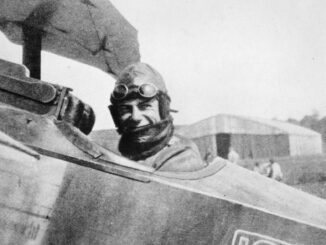 Since the beginning of aviation, pulling off the impossible was a quite popular stunt among the pilots. Especially the well-known landmarks were seducing aviators for a spectacular flight around or through them, that could bring popularity and attention. Some of those incredible tricks were carefully planned in advance, but many were done spontaneously. Just a couple of such flights are still good remembered and most of them, regrettably, had slumber into oblivion. And here is a short story introducing a few of them…
Since the beginning of aviation, pulling off the impossible was a quite popular stunt among the pilots. Especially the well-known landmarks were seducing aviators for a spectacular flight around or through them, that could bring popularity and attention. Some of those incredible tricks were carefully planned in advance, but many were done spontaneously. Just a couple of such flights are still good remembered and most of them, regrettably, had slumber into oblivion. And here is a short story introducing a few of them…
The Bastille Day Military Parade is a traditional French military celebration, being held annually, in the morning of 14th July. In 1919, less than a year from the day the Great War ended, it was a perfect occasion to celebrate victory over the Central Powers. The representation of all French armed forces and delegations from all allied countries took part in this spectacular défilé de la Victoire. And obviously, the French aviators, being still considered as heroes of the World War I, participated in the celebrations, marching among the other soldiers.
Yes, they marched, as any other soldier. There were no aeroplanes allowed to fly above the parading troops, and the French military pilots considered this both a provocation and an intentional act of humiliation. Not allowing their honour to be stained, the Great War veterans decided to perform a spectacular act, showing the whole world a pride of the French military pilot.
In fact, the idea was already discussed weeks before the holiday, when it was clear they could not perform during the parade. During an informal meeting in ‘Fouquet‘ bar on the Champs Élysées, and after a few too many drinks, the objective was approved – someone of them would fly under the Arc de Triomphe on 14th July, during the parade.
The chosen one was Jean Navarre, nicknamed ´The Sentinel of Verdun´ – a popular air ace with 12 confirmed and 15 unconfirmed victories. Navarre started to practice the low-flying techniques at Villacoublay airfield, but unfortunately was killed on 10th July, while his aircraft crashed during one of training flights. Charles Godefroy, a flying instructor with more than 500 flying hours, immediately volunteered to replace Navarre. Regrettably, it was too late to fly under the Arc on the parade day. Godefroy also needed some training and the flight had to be postponed.

The clearance of the Arc de Triomphe is 14,50 metres, so Godefroy decided to fly under the Arc with Nieuport 11 Bébé, a small sesquiplane fighter aircraft introduced in 1916. With its wingspan of 7,52 metres he should have enough space to perform this adventurous flight. As the flight was now scheduled for August, without a witnessing crowd at the parade, a French journalist Jacques Mortane was asked to film the whole event.
On 7th August 1919, Godefroy took-off from Villacoublay and headed Paris. At first, he circled the Arc twice and then suddenly passed through it at a very low-level flight. His Nieuport almost hit the tramway passing by and the passengers threw themselves to the ground in panic.
On the following day, all newspapers reported the event, however the name of the brave pilot remained unknow to the public. Unfortunately, Mortane´s film was almost immediately banned by the police, and a few days later, the following investigation revealed the pilot´s name. Nevertheless, Godefroy escaped only with a warning – probably because this was his very last flight. Taking into the consideration his family, being frightened by his stunt, Godefroy promised to give up with flying and became a wine trader.
As time went by, flying under the Arc became a dream for many pilots, but there were only two, who managed to follow Godefroy and repeat his achievement.
Alain Marchand, a 47-year-old flight instructor managed to fly through the Arc on 18th October 1981. He performed his flight in SOCATA Raylle, a French-manufactured light aircraft with a wingspan of 9,74 metres. Marchand, by repeating the Godefroy´s stunt, wanted to draw attention to – what he said – was the tragic economic situation of general aviation. This time, the police were indulgent, and he was fined 5,000 French francs.
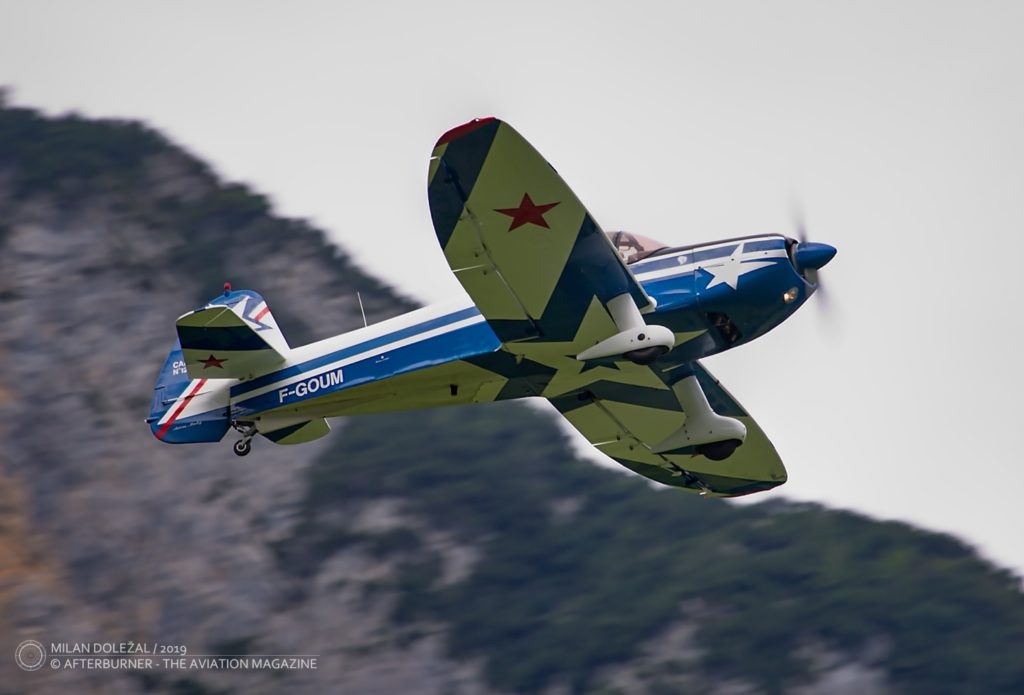
The name of the third pilot remains unknown – on 16th August 1991, an anonymous aviator has stolen a Mudry CAP 10B light aircraft (wingspan 8,06 metres) from the aeroclub at Lognes, in the astern suburb of Paris. Then he flew not only through the Arc but also under the Eiffel Tower. Knowing the conclusion of Marchand´s flight, his acting could be understandable, even though being not a behaviour pattern to encourage.
Since we have already mentioned the Eiffel Tower, it was, together with the Arc de Triomphe, another famous building in the French capital, attracting aviators since the early years of aviation.
The first remarkable attempt, reported by newspapers, occurred in 1926. A French military pilot, Lieutenant Léon Collot, made a bet with an unknown American to fly beneath the span of the Eiffel Tower. Collot managed to fly under the tower in a biplane, but blinded by the sun, he hit the aerial while trying to ascend. The flight was witnessed by several photographers and filmed – according to the newspapers, they were still filming the scene when Collot was trying to get out from his burning aircraft. The French police immediately banned the film to be distributed in France, being shortly followed by American and English authorities.
Most likely, the first successful passing under the Eiffel Tower happened in 1944, however there is no clear evidence of that event. In spring of 1944 (the exact date remains unknown), William Overstreet Jr., a young fighter pilot from the 363rd Fighter Squadron was dogfighting with a German Me 109 over Paris. Flying low over the city, Overstreet was pursuing the enemy fighter and managed to hit its engine. In a desperate attempt to out-manoeuvre Overstreet, the German pilot flew under the Eiffel Tower – followed by American pilot in his P-51 Mustang. The Me 109 crashed after the pass, as a result probably making Overstreet and ´Berlin Express´ (as the P-51 was named) the first to successfully fly under the span of the tower.
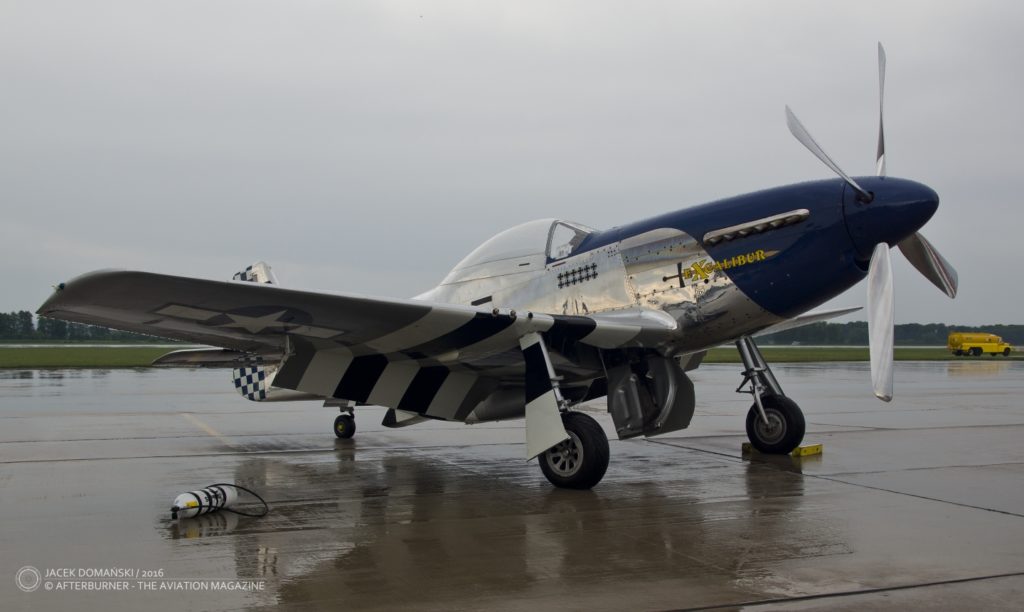
Although this was a remarkable achievement and a spectacular air victory, Overstreet for the first time mentioned it when the World War II was over. Regrettably, there are neither any clear evidence of this pass under the tower, nor confirmation of the dogfight over the city. The date is unknown, the air victory was not reported by American or German side, and there are no eyewitness reports. William Overstreet, in 2009 being presented the French Legion of Honour, died in 2014, aged 92.
The first officially confirmed flight beneath the tower span was reported on 14th September 1944. A Mosquito Mk. XIII of No. 409 Squadron RCAF was brilliantly photographed exactly while passing under the tower. Although the flight was confirmed, there are still some uncertainties related to the crew and the aircraft.
What is considered the most probable version, is that the pilot of this successful flight was F/O Robert Fullerton (RCAF). However, there is also another evidence, saying that the pilot´s name was W/O Bob Boorman (RCAF). Was there two separate flights under the tower or was just Boorman´s name used to cover Fullerton´s identity due to his later high rank in RCAF – this remains uncertain. The navigator, F/S Bill Bryant (RAF), unfortunately did not reveal this secret before his death.
Nevertheless, and similarly as in Collot´s flight, the reason behind this remarkable stunt was a bet – the Mosquito crew met with American journalists in the bar and agreed to pull off the impossible. This explain also the high quality photo from the pass, as it was taken by a professional photographer of unknown identity – the original is now owned by Comox Air Force Museum.
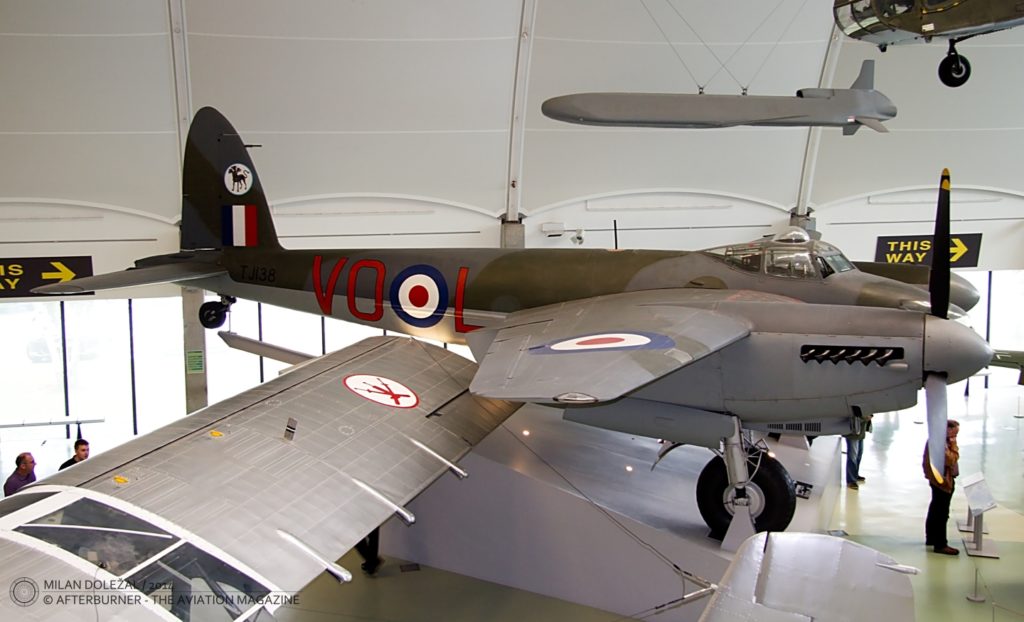
Third time´s a charm, the proverb says, and this was also confirmed with the Eiffel Tower. On 31st March 1984, Robert Moriarty, a retired US military pilot, flew under the tower with Beechcraft Bonanza. Moriarty, a former F-4B pilot and a youngest naval aviator during the Vietnam War, is also a holder of several aviation records in different categories. In 1984 he participated in Paris to Libreville air race but was forced to quit, due to engine failure. After repairing his Bonanza, he decided to perform something spectacular – and flying through the tower arches was exactly following this idea. His flight was filmed both from the aeroplane and from the ground, asked by the French media about the reason behind, Moriarty answered, that it was just for fun.
As already indicated, such famous city landmarks, as the Arc de Triomphe or the Eiffel Tower, always led the aviators into temptation, inducing them to act unconventionally. And obviously, also the cities other than Paris witnessed some spectacular stunts.
Ernst Udet, the German air ace from the Great War era with 62 victories, was one of the most-known pilots in the 1920s and 1930s. His legendary skills were world-wide known, and the stunts he performed at aviation events attracted large crowds. In 1935, while making ´Wunder des Fliegens: Der Film eines deutschen Fliegers´ (´The miracle of flight: a film about a German airman´) he performed an incredible stunt in Munich. This time it was not about flying under any building, but just the opposite – he flew at an angle through the Frauenkirche (´Cathedral of Our Dear Lady’) towers, with the clearance between them of about 10-12 metres.

Udet was also witnessed, however no photo evidence is known, to fly under the Isar bridges in Munich and to loop the Großhesselohe railway bridge. He also landed at the snowy Zugspitze, at 2,962 metres being the highest mountain in Germany, and then took-off from there.
Paris has the Eiffel Tower, Munich has the Frauenkirche and London has a Tower Bridge – being a famous landmark of the English capital, the bridge was also a popular target since the pioneer years of aviation. The Tower Bridge is a combined bascule and suspension bridge, with two towers, tied together with an additional walkways. The clearance between the walkway and the deck is 141 feet / 42.977 metres.
The first successful flight under the Tower Bridge was reported as early as 1912. One of the founding members of the Royal Air Club, civil engineer and aviation pioneer Frank McClean (later: Lieutenant-Colonel Sir Francis Kennedy McClean) took-off from Isle of Sheppey on 10th August 1912, flying a modified Short S.33 floatplane. ´Approaching London Mr. McClean brought his machine lower down and negotiated the Tower Bridge between the lower and upper spans´ – as ´Flight´ magazine reported a few days later. Considering this stunt too easy, McClean continued his flight along Thames, flying under all bridges to the Westminster Bridge. On the next day he tried to fly the way back, one more time repeating his stunt, but the weather was significantly worse, and McClean crashed near the Shadwell Basin. Fortunately, no one was hurt, and also the aeroplane was easily repaired.
On 21st March 1919, an Australian aviator, Flight-Lieutenant Sidney Pickles, became the second pilot who ´shot the bridge´. Flying a Fairey seaplane – a common tale is that Mr. C.R. Fairey accompanied him – he got it through the Tower Bridge again. As a result, flying under the bridges in England was officially forbidden by law.
However, this legal provision did not stop Major Christopher Draper to perform another pass in 1931. Draper, despite being a famous English air ace from the World War I era, shared the sad fate of many war veterans – after the war he was working as a car salesman but later desperately trying to return to flying. In September of 1931 Draper was both jobless and without a penny in his pocket. Driven by an idea, that later was defined as his bold attempt to protest against the treatment of the Great War veterans, Draper borrowed DH.80A Puss Moth aeroplane and was going to fly under all 14 Thames bridges. Due to the bad weather conditions, he finally made it through the Tower and Westminster Bridges, receiving the nickname of ´Mad Major´.
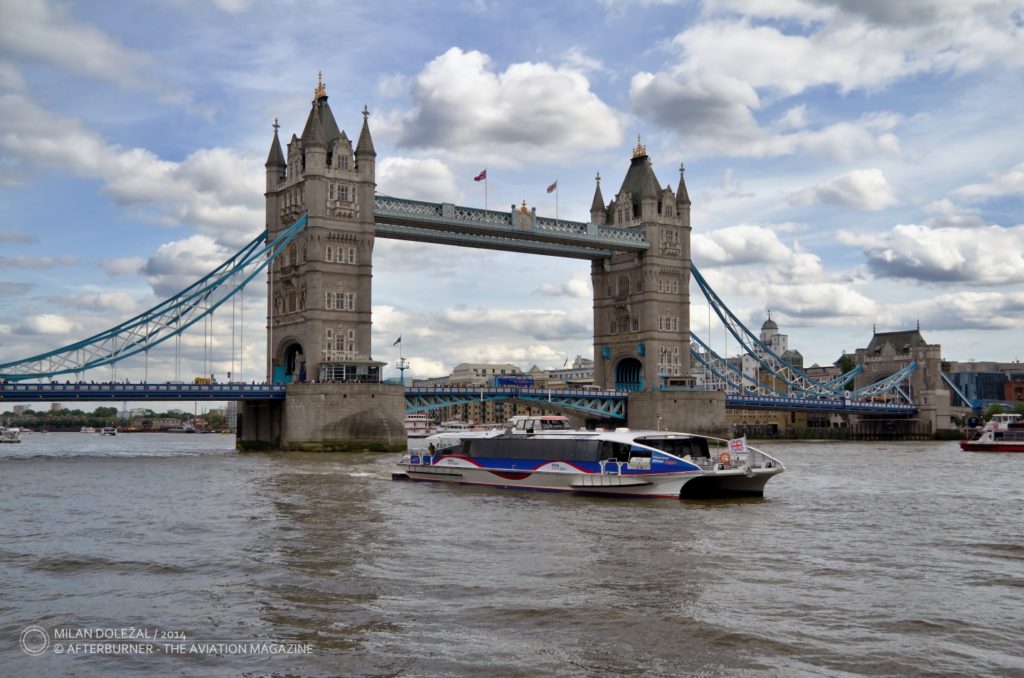
Draper´s performance was filmed and later he started to work as a stunt pilot and even an actor. He was also a British secret agent, a double agent to Germany (he knew Hitler personally) and eventually returned to British Navy during the World War II. He is reported to fly 73 types of aircraft, clocking more than 17,000 flying hours.
Surprisingly, no one tried to fly through the bridge during the World War II years. The Londoners had to wait twenty years for another stunt, but the patience has paid off, as there were already two flights with a short gap between them. In 1951, an amateur pilot named Frank Miller, was flying for fun with his 13-year-old son. And this was a teenager´s idea to fly through the bridge with their Auster aeroplane. Miller was then fined 100 pounds, but his son supported him with 35 shillings, the all savings of a teenager.
The wheel of history goes round and the situation of World War II veterans in 1950s was resembling the years after the Great War. And, similarly as in 1931, there was a pilot who was penniless and wanted to protest against the government´s treatment to the veterans. He rented an Auster aircraft and was going to fly under 15 of London bridges. The name of this pilot was… Christopher Draper – after being jobless for more than a year, he performed another desperate stunt to draw attention on himself.
On 5th May 1953, Draper took-off for his spectacular flight, this time completing his objective. He was then fined only a ten guinea court fee and his flying licence was revoked. However, the ´Mad Major´ managed to restore it shortly afterwards, flying actively until he was 71.

1968 was a turbulent and revolutionary time for the world, but other than that, it also meant a 50th jubilee anniversary for the Royal Air Force. The World War II was still well remembered, the Cold War was at its peak, and the British pilots were still loved by the crowds. However, the political sphere did not share such expression. The fascination with guided missiles that arose in the late 1950s and was finalized by the 1957 Defence White Paper, considered the manned aircraft an old hat.
This was a wound to both British aircraft industry and the military aviation, a wound that never healed. The RAF was facing a structural reduction and the morale went straight down. For many pilots, including the F/L Alan Pollock, a flight commander in No. 1 Squadron RAF, the final straw was the golden jubilee of the oldest air force in the world. There were some local events organized at the anniversary, but without any big celebration and, primarily, without a flypast over the capital city. The 1st of April, the anniversary day, was a usual day of duty for the RAF.
Pollock decided to perform a flypast on his own, obviously not authorized. And then opportunity strolled right in the door – on 4th April 1968, Pollock and his colleagues were flying from West Raynham to Tangmere, the former home of No. 1 Squadron, for the official event held there. On the following day, their route back home was crossing the London area, and F/L Pollock broke away from the formation for his one man show.
Initially he intended to perform a flypast and fly over the Houses of Parliament in a symbolic protest against Harold Wilson’s government. Then, as he forecasted, he would be judged, and this could be an opportunity to explain the reasons behind this act of defiance.
At the beginning, all went as planned. Pollock circled the Houses of Parliament three times, coincidentally interrupting the discussion about noise abatement. Then he followed Thames on a way back and while the Tower Bridge appeared in front of him, a crazy idea flashed upon his mind. In a second, he decided to ´shot the bridge´, fully relying on his low level-attack trainings.
As a result, Alan Pollock became the first pilot who flew through the Tower Bridge in a jet aeroplane – Hawker Hunter FGA.9. Knowing what the consequences might be, on the way back to West Raynham he visited a few air bases, reportedly flying inverted over their runways.
Obviously, this was the final flight in Pollock´s military career, however he wasn´t able to make a point in the court. Afraid of the popularity he immediately received, the authorities decided to skip the martial court phase and Pollock was invalided from RAF due to medical reasons. His squadron was, as a precaution, transferred to North Africa. In 1982, Alan Pollock was officially cleared of any wrongdoing related to his unauthorised flight.
Regrettably, also for the RAF pilots, there were a few attempts of performing a spectacular flight that did not concluded in a successful finale.
As a result of already mentioned reduction of the British military aviation, many RAF squadrons were disbanded – among them was No. 501 (City of Bristol) Auxiliary Squadron. The official disbanding celebration was held on 3rd February 1957 and the parade and flypast were planned.
On early morning that day, F/O John Greenwood Crossley took-off for the test flight before the parade, flying a Vampire FB Mk.9 fighter. It is not known that the pass beneath the local landmark, Clifton Suspension Bridge, was planned earlier, or it was just a split-second decision. Unfortunately, Crossley lost control of the aircraft and hit the gorge of Leigh Woods, killing himself instantly.
Crossley was one of about a dozen pilots who tried to fly under the Clifton Suspension Bridge. The first attempt was reported as early as 1911, but no one else tried to shoot this bridge since the tragic flight of the Vampire in 1957.

Sources:
The Mad Major – The Autobiography of Major Christopher Draper DSC (Air Review Ltd., 1962) / magazines and newspapers from the era, including:
Flight No. 190. (No 33, Vol. IV.) 17 August 1912; Sunday Times; New York Times; Le Figaro; L´Echo de Paris


